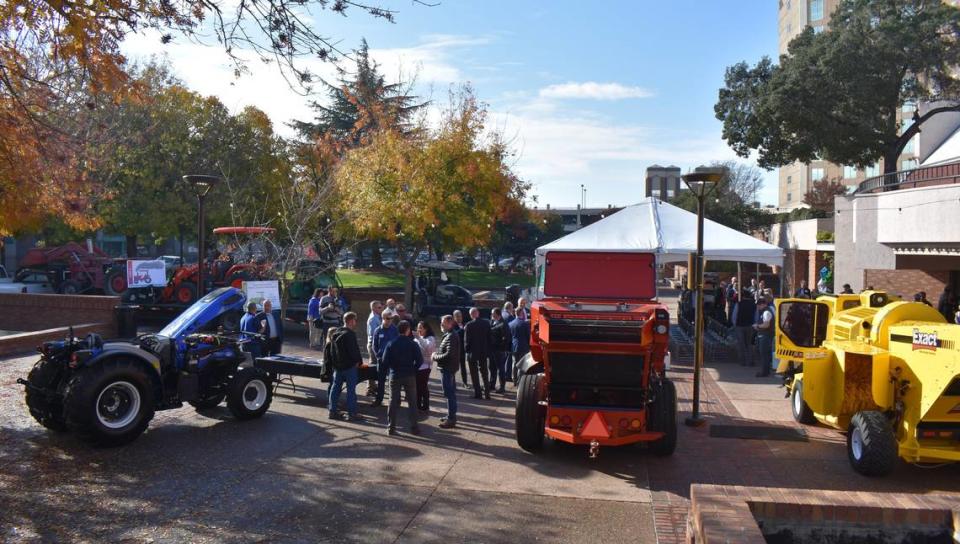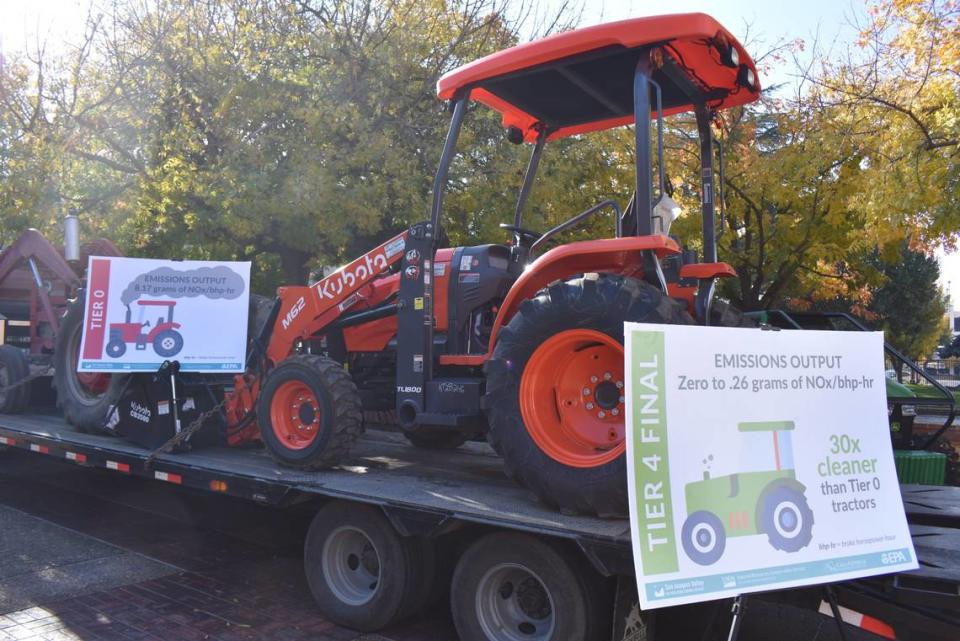Incentives help Stanislaus farmers meet the goal for cleaning Central Valley air
This story is part of a Modesto Bee series on climate change impacts for the Stanislaus region.
Farmers in the San Joaquin Valley have met a commitment to reduce emissions by replacing older tractors and other equipment with cleaner machines. State, federal and local officials came together in Modesto on Wednesday to recognize efforts that have eliminated 11 tons of nitrogen oxide emissions daily.
The Valley agriculture industry replaced and destroyed 12,800 pieces of older equipment, almost 60% of which had no emission controls.
According to the U.S. Environmental Protection Agency, nitrogen oxides are poisonous gases that come from burning fuel in automobiles, farm equipment and industrial boilers, and react with other compounds to produce smog. Nitrous oxide (one of the nitrogen oxides) accounts for 6% of human-caused greenhouse gases in the United States that are warming the environment.
“We have a lot of work to do still,” Assemblywoman Esmeralda Soria, D-Merced, said at the Clean Air Ag Equipment Showcase at Modesto Centre Plaza. “It is amazing how far we have come, but we need to push for more. ... We can’t let up in the work you are doing.”
The transition to low-emission farm equipment contributes to long-term initiatives to improve air quality in the eight-county San Joaquin Valley Air Pollution Control District and also helps to cut emissions that are warming the planet.
The mountain ranges bordering the Valley create a bowl that traps air pollutants, exposing the region’s 4.3 million residents to some of the worst air quality in the nation.
The equipment on display at Centre Plaza included tractors up to 30 times cleaner than those made 25 years ago, electric utility vehicles and low-dust nut-harvesting equipment.
Manuel Cunha Jr., president of Nisei Farmers League, said low-emission tractors are tricky to operate, with their heat sensors and electronics, but “the farmers are willing to work through that.”

Far lower emissions with new tractor
Cunha referred to an informational display comparing a Massey Ferguson tractor, which was destined for the junkyard, and a low-emission Tier 4 tractor. The older tractor has spewed hourly smog-forming emissions of 8.17 grams per horsepower, compared to .26 grams emitted by the new tractor.
Cunha said a first round of farm equipment conversion from, 2008 to 2015, achieved 15 tons of daily nitrogen oxide reduction in the Valley after the industry was asked to cut five to 10 tons.
Federal and state grants have covered around 80% of costs for the low-emission equipment, while the farmer puts in 20% to 30%, Cunha said. “It is a challenge to be competitive, but the only thing that helped us was incentives,” he said.
Samir Sheikh, the air district’s executive director, said thousands of older tractors need to be replaced to help clean the Valley’s air.
In another transition to reduce carbon emissions, agricultural burning has been reduced by more than 80% and the phaseout could virtually eliminate the historical practice next year, Sheikh said.
The transition has required developing alternatives to open burning. A grower pulling an old vineyard or orchard may consider putting the woody material in the ground. It may require hiring a contractor to process the wastes, so resources are needed to defray some of the costs, especially for smaller farmers, Sheikh said.

Sustainable farming is big priority
Sheikh said sustainable and air-friendly agricultural practices are a big priority in California and deserve support from multiple agencies. Some other strategies include electrifying pump engines and conversion to low-dust harvesting equipment.
Stanislaus County Supervisor Vito Chiesa, a Hughson farmer and air district governing board chairman, said low-emission tractors owned by his family’s farm operation are able to meet emission standards in the top two tiers. He said there are concerns among farmers about electric tractors and the lifespan of batteries, but the technology is advancing quickly.
Roger Isom, president of California Cotton Ginners and Growers Association, said the success with reducing nitrogen oxide emissions demonstrates the value of incentives. “This is the way you do it — an incentive program,” Isom said. “It is not mandatory, and if a farmer can’t do it, he doesn’t. But you meet the goal.”
Isom said he has doubts about California’s climate goals to phase out diesel trucks. A battery-powered truck costs $450,000, twice as much as a diesel rig, and the range of electric trucks is limited. The other alternative is trucks powered by hydrogen fuel cells, which have a price tag of more than $500,000, Isom said.


